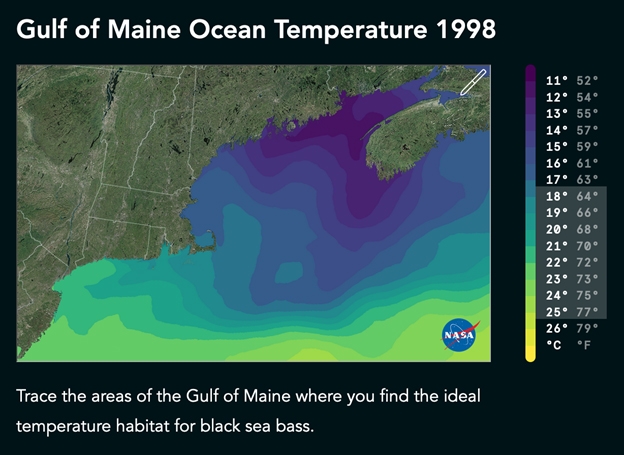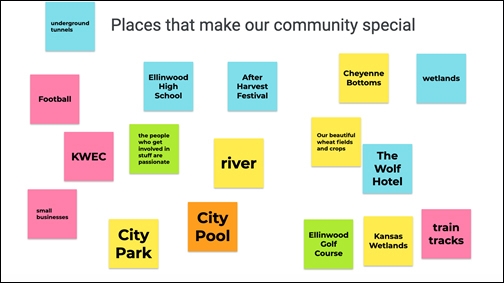Active Involvement
What is active involvement? Educators provide opportunities for students to engage with or actively manipulate materials and/or ideas.
What does it look like in practice? Students may complete an independent task or activity during the program such as drawing, creating a model or analyzing data or participating in a game. They may create products to share and discuss.
Gulf of Maine Research Institute Interactive Mapping Activity
This program is a synchronous exploration for fifth and sixth grade students. Over the course of 3-5 days with an educator, they investigate how warming ocean temperatures are changing the Gulf of Maine ecosystem.
The Sea Surface Temperature Activity investigates how ideal temperature habitat for black sea bass has changed over time. Students use a mouse or trackpad to trace the ideal temperature habitat at four time points, from 1988 to 2018. Then, they use a slider to overlay the four lines and explore data trends. Finally, they respond to the question: How is the ideal temperature habitat for black sea bass changing?
Gulf of Maine ocean temperature 1988

This activity exemplifies active involvement because students are outlining temperature ranges and moving a slider to view how their outlined areas have changed over 20 years. They analyze data in response to a question about change over time.
Kansas Wetland Education Center Jamboard Activities
The Wetlands Metaphor program is a synchronous virtual program designed for middle school students. This program lasts for 70 minutes and emphasizes the importance of wetlands for migratory birds. It includes some content delivery through videos and slides along with discussion, polls and Jamboard activities.
Students participated in a two-part Jamboard activity. First, the educator asked students to write down one of their favorite places in their community on a virtual sticky note.
Places that make our community special

Next, she divided the Jamboard into two sections: “natural” and “man-made” places. She asked students to move their sticky notes based on whether their favorite place is natural or man-made.
Later, students played Pictionary on Jamboard as she reviewed key concepts. She sent a word to a student in chat, and then they drew an object while other students guessed what it was on chat. Once students guessed the organism, she shared a few facts about why it was important to the ecosystem.
Students made drawings of a cattail, a dragonfly and a pelican.
Cattail

Dragonfly

Pelican

This program exemplified active engagement by having students engage with and manipulate sticky notes as they considered the differences between natural and man-made structures and places around them, setting the stage for a discussion about Cheyenne Bottoms preserve. Also, students played a game that involved drawing on Jamboard and guessing by writing in the zoom chat feature.


